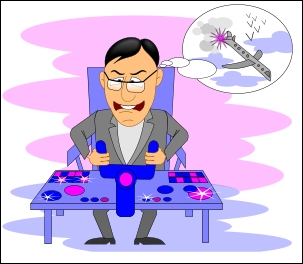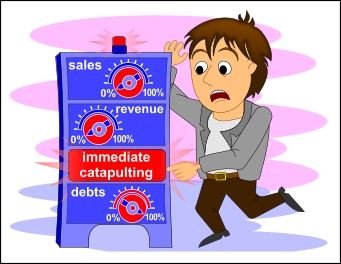Author: Eugene Akinshin, Ph. D., Chief Technical Evangelist for Perpetuum Software LLC
Do Androids Dream of Electric Sheep?
If you read title of this article and didn’t exit the page, you probably know that implementation of various dashboards in business applications is rather new and popular trend. As all new tendencies that don’t have firm rules, executive dashboards raised a lot of discussions on practical usefulness of both complete concept and separate dashboard elements. One of the points at issue is the use of graphical elements imitating real analog devices to represent values. In this article I tried to state basic principles of using such elements.
In general, initial meaning of the Executive Dashboard term faintly relates to real dashboards and means special type of reports providing the most important business performance indices in real time. It is expected that Executive Dashboards as well as all other reports provide data in tabular form and more rarely as charts and diagrams. Though, powerful graphical tools that are used by developers and users of business systems boost literal interpretation of the Dashboard term.
As I am a power engineering specialist by training, I faced quite a lot of point indicators (gauges) in practice. And contrary to the widespread opinion that such devices are extremely convenient in most cases it is not true. Anyone who has ever worked with point and numeric multimeters can confirm that numeric meters are more convenient since you don’t need to wait till the pointer stops, strain your eyes to match pointer reflection on the mirror strip with the pointer itself and to count divisions on the scale. And, of course, to get accurate registration you need to keep the device right before your eyes (or eyes before the device). Vibration and poor light don’t contribute to getting accurate registration.
At first, the idea of using control panels (dashboards) in business applications seemed incredible to me. What? Back to lithic age? Do you really want to fill the whole screen with these archaistic point devices? Leave no pixels to display hundreds of indices that are even more important for business analysts then those in the screen?
 This impression was reinforced by Executive Dashboards I have already seen, as they were eye-catching and useless. Do you think that CEO report should look exactly like car dashboard? Of course, not. This is not prestigious; it should look like PLANE dashboard! So, most of such creative solutions impress at presentations, but they are completely useless in practice.
This impression was reinforced by Executive Dashboards I have already seen, as they were eye-catching and useless. Do you think that CEO report should look exactly like car dashboard? Of course, not. This is not prestigious; it should look like PLANE dashboard! So, most of such creative solutions impress at presentations, but they are completely useless in practice.
In spite of that, as a co-owner of the company that specializes in development of components designed to emulate real dashboards, I couldn’t but become interested in a new market for our products. More careful analysis discovered that along with the mentioned before “masterpiece” dashboards there is quite a good number of perfect samples of using gauges.
And although I still think that the use of gauges is reasonable only in some business applications, correct utilization of such components can dramatically improve application usability and even raise it to a new level.
Let’s sort out what ‘correct use’ means and what real advantages gauges provide.
1. GOOD METAPHOR
Almost all user interface development guides state the first main rule: “Choose good metaphor”. Sometimes metaphor comes from subject area. So, when you develop graphic editor it makes sense to use metaphor that includes paper, pen, rubber, i.e. the concepts the user faced with before in real life and has an idea of their behavior and functions. But very often subject area is more abstract and good metaphor is a real problem. Usability specialists state that right metaphor is a key factor that determines application success, as it can extremely reduce evaluation and training time.
What have gauges to do with it? Gauge is a natural metaphor for many things.
We use thermometer since childhood and get a clear idea that if stem of the thermometer is in the red zone, temperature is higher than it should be etc. Those who drive a car, every day watch registration of point devices.
I think these samples present a clear idea that visual elements should be designed in the way their appearance provides as much information on the type of displayed values as possible.
For example, displaying value on the point device means that all acceptable values are in the range determined on the scale. Slider gauges show that value can be changed by the user. Availability of scale segments helps define bounds of value ranges. Blinking elements warn against errors or going beyond acceptable values range.
Thus, novice user of the system will have no trouble to learn system interface. At the same time it would be better to provide more informative interface with less graphic to experienced users.
2. SPEED OF PERCEPTION
 Speed of information perception is one of unquestionable merits of analog gauges. Reaction to pointer moving towards the red zone or blinking indicator can be much faster then reaction to changing numeric indicator.
Speed of information perception is one of unquestionable merits of analog gauges. Reaction to pointer moving towards the red zone or blinking indicator can be much faster then reaction to changing numeric indicator.
That is why the supermodern fighters use out-of-date dashboards with a lot of pointers and indicators.
Stop! What have fighters to do with it? We talked about business, not about war. It is not matter of milliseconds; you can relax and have a cup of coffee before you make important decision, can’t you?
Well, let’s calculate.
Every manager regardless of his level regularly reviews the same reports in most cases daily and in most cases just to make sure everything is ok. As a rule it doesn’t take much time – only 10 minutes a day.
- 10 minutes a day is 10*5=50 minutes a week;
- is 10*5*4= 200 minutes a month;
- is 10*5*52=2600 minutes a year (ok, I know 4 week I a vacation, let it be 10*5*48=2400 minutes a year).
Suppose we will reduce time of reviewing reports to 1 minute due to higher speed of perception. In this way we will save 9*5*48=2160 minutes a year; this constitutes 4.5 working days. Multiple this figure by your hour wages (or hour wages of your employees) to evaluate economic effect.
And this is for people who spend only 10 minutes a day for reports. And what about analysts?
3. VISUALIZATION
Very often it is difficult to make right decision based on bare data. Human brain operates by visual images and not by mathematical abstractions. Properly designed gauge allows visual evaluation of the extent the displayed value differs from the planned one, and how close it is to the critical value, etc.
But you should remember that visual indicators don’t replace exact figures, but supplement them. That is why you should never forget to duplicate values as figures. You should always know exact value regardless of visual representation.
4. AESTHETICS
 Applications should be attractive as well as any other things we use. As human beings we like using nice things no matter useful they are for business or not. Moreover, comfortable environment contributes to more efficient work of your personnel; people are less tired and stress-susceptible. You didn’t paint walls in your office with black color only because black paint is cheaper, did you? Then why should you strain your eyes observing neat rows of figures that merge into solid mass by the end of working day to find necessary data. Make application interface more attractive and many routine operations will become less tedious.
Applications should be attractive as well as any other things we use. As human beings we like using nice things no matter useful they are for business or not. Moreover, comfortable environment contributes to more efficient work of your personnel; people are less tired and stress-susceptible. You didn’t paint walls in your office with black color only because black paint is cheaper, did you? Then why should you strain your eyes observing neat rows of figures that merge into solid mass by the end of working day to find necessary data. Make application interface more attractive and many routine operations will become less tedious.
SUMMARY
Visualizations such as gauges can be a useful supplement to standard report representation. But to use gauges in applications efficiently, you need to accurately adjust visual elements to exact applications subject to used metaphor, visualization, speed of perception and design of the developed application.
If you decide that gauges are necessary in your reports, I am the very guy who will sell the best library to create such interfaces.
[...] it was mentioned in one of the previous articles, appropriate use of gauges and other data visualization elements in corporate statistics helps save [...]
Hello,
Not sure that this is true) but thanks
Thank you
Jinny
Thank you …
Cheers,
Ekaterina